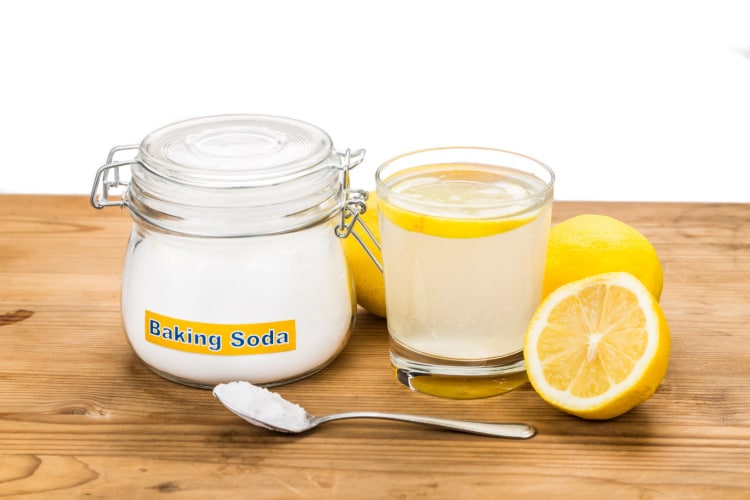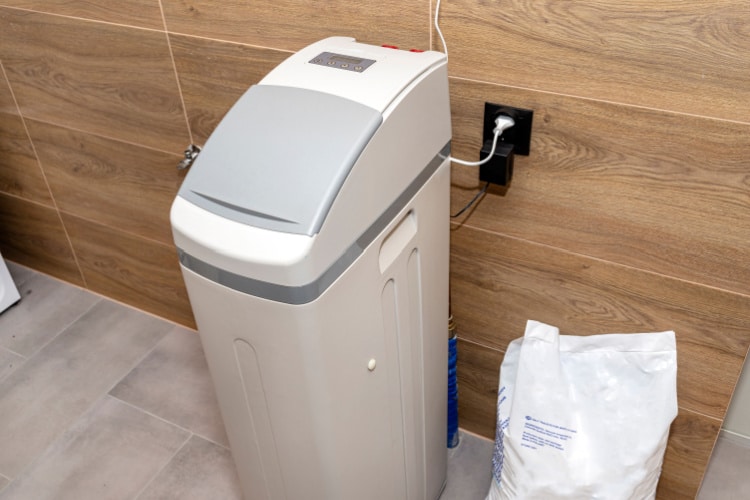Although unusual, it’s not a surprise to find spots and stains on a stainless steel material after long term buildup of calcium and magnesium hard water minerals. These minerals not only cause stains on stainless steel surfaces, but also on tiles, glass, car windows and home appliances.
Fortunately, there are several easy ways to remove and prevent hard water stains on stainless steel, which we’ll discuss below.

How to Remove Hard Water Stains from Stainless Steel
There are five effective methods for removing hard water stains from stainless surfaces:
However, the application of these methods will depend on the type of stainless steel appliance you have and the manufacturer’s recommendations.
1. Use White Vinegar to Remove Hard Water Stains from Stainless Steel Appliances
White vinegar is one of the most traditional methods for removing mineral buildup and limescale formation because its acid content can unbind the hard water mineral molecules that are sticking together. This is also what makes it one of the best methods to sanitize a water softener.

To remove water stains on stainless steel appliances, you need a bit of white vinegar and a soft sponge or a cleaning cloth. Our recommendation would be a micro-fiber cotton cleaning cloth, but even a couple of paper towels can do the job.
How to remove hard water stains from stainless steel using white vinegar:
- Spray or pour a bit of white vinegar on the stained surface
- Let it sit for about 4 to 6 minutes so that the chemical reaction between the acid and the mineral molecules can take place
- Grab your cleaning cloth/sponge/towel and gently wipe the stained surface. Make sure that the direction of your wipe is the same as the grain structure of the stainless steel appliance.
- If the stain remains after you wipe the appliance off, repeat the process until it’s gone
2. Use Baking Soda and Lemon Juice
Baking soda is another conventional method for eliminating the adverse effects of hard water on stainless steel. Unlike white vinegar, which is acidic, baking soda is alkaline, which is why it’s paired with the highly acidic lemon juice.
When the sodium bicarbonate in the baking soda is mixed with the citric acid that’s amply present in lemon juice, it creates a chemical reaction that forms acidic bubbles. These acidic bubbles destroys the bonds between hard water mineral molecules and easily separate them from the surfaces they adhere to.

How to remove hard water stains from stainless steel using baking soda:
- Pour or spray some lemon juice on the stained surface
- Wait for it to settle on the buildup for about five minutes
- After five minutes, spray some baking soda on the lemon juice
- Wipe off the surface with a cleaning cloth
- Then, grab another cleaning cloth (as the first one is already stained) and wipe again to ensure no baking soda and lemon juice residue remains on the surface
- Air-dry the appliance
3. Use Chelating Agents
Calcium and magnesium hard water minerals have positively charged ions, and chelating is a widely-used industrial technique to bind these ions. In the chelating process, a specifically designed molecule called chelant is utilized to prevent mineral molecules from building up and adhering to surfaces.
Nowadays, Chelants are frequently found in cleaning products like detergents, soaps, and shampoos. So, any product with chelants as an active ingredient can help you remove water stains from stainless steel.

How to get water stains off stainless steel using chelating agents:
- Make a detergent/soap/shampoo solution with water in a pot
- Lay a cleaning cloth in that solution and make sure that the cloth is completely submerged
- Rub the stained surface with the wet cleaning cloth
- Use another cleaning cloth to wipe the cleaning agent from the surface
4. Use Isopropyl Alcohol
Isopropyl alcohol is a popular solvent made of propylene and sulfuric acid used in many everyday products, from cosmetics to aftershave lotions and gum. It is also referred to as rubbing alcohol because it’s a strong antiseptic.
Similar to white vinegar and lemon juice, its acidic content makes it quite effective for removing hard water stains.

How to use Isoproply Alcohol to get rid of water stains on stainless steel:
- Apply isopropyl alcohol to a soft cleaning cloth. Make sure the whole cloth is thoroughly wet.
- Rub the water stains with the wet cloth
With alcohol, you don’t have to rinse out the surface you cleaned as it’ll evaporate by itself.
5. Stainless Steel Cleaner

There’s a wide variety of stainless steel cleaners available on the market that are quite effective at removing hard water stains from stainless steel. More often than not, these products are made of chelating agents.
Stainless steel cleaners are mostly sold as sprays or wipes, and the best product we recommend is the Weiman stainless steel cleaner.
To use a stainless steel cleaner, just apply the cleaner to stained surfaces as instructed by the manufacturer, and the hard water stains will be gone.
How to Prevent Water Spots & Stains on Stainless Steel
Since many households across the United States have hard water, the long-term solution to hard water stains is to completely eliminate the calcium and magnesium minerals by using water treatment solutions like water softeners, water conditioners, and water descaler.
Use a Water Softener to Remove Hard Water Minerals
Water softener is the best and most common solution to hard water problems.
A traditional water softener attracts and traps positively charged calcium and magnesium minerals thanks to its negatively charged resin. This resin then replaces these molecules with negatively charged sodium or potassium ions that don’t affect the hardness of water.
To ensure that the resin maintains its negative charge, a brine solution (a.k.a. salt/sodium/potassium solution) is prepared in a separate tank. This solution then travels through the water softening system to flush the mineral buildup from the resin and recharge it with new sodium or potassium molecules in an automated process known as the regeneration cycle.

The most highly rated water softener you can get is the Springwell SS1 Salt-based water softener, which uses ion-exchange to remove hard water minerals and save detergent consumption by 40%. Other water softener options can be found in our best water softener systems article.
Use a Water Conditioner
Water conditioners, or salt-free water softeners, don’t depend on a resin to replace the hard water minerals. Instead, they use a technique called template-assisted crystallization (TAC) to turn mineral ions into microscopic crystals that won’t stick to surfaces.
However, unlike traditional water softeners, TAC-based systems don’t remove minerals from water; rather, they only change their chemical structure. Because of this, their efficiency levels are slightly lesser than salt-based water softener systems. Whereas a salt-based system can reduce the minerals present in water by 99%, that number is 90% for most salt-free conditioner.

The most highly rated salt-free water softener you can get is the Springwell FS1, which provides 99.6% scale prevention without using salt. Other salt-free water softener options can be found in our best salt-free water softener systems article.
Use a Water Descaler
Water descalers are also known as electromagnetic water conditioning systems since they break the bonds between mineral molecules by sending electromagnetic pulses via a magnetic band wrapped around the main water pipe.

These pulses alter the chemical structure of hard water minerals (calcium and magnesium) and prevents them from sticking to the surfaces of appliances, tiles, and pipes. As a result, the mineral buildup that might lead to hard water stains on stainless steel appliances is significantly reduced.
That said, the efficiency level of water descalers is even lower than that of salt-free water conditioners. They can only reduce scale by 50%, which may not be enough if you live in an area with very hard water.
Conclusion
You can remove hard water stains from stainless steel with either white vinegar, baking soda and lemon juice, a cleaning detergent that contains a chelating agent, isopropyl alcohol, or a stainless steel cleaner. However, you also need to handle the root cause of the problem by completely eliminating the hard water minerals in your water.